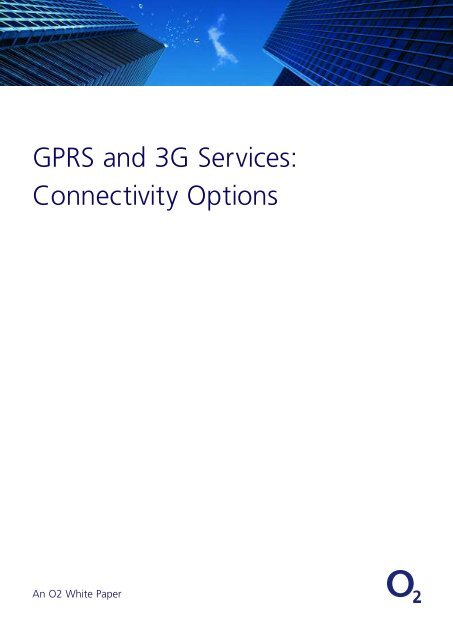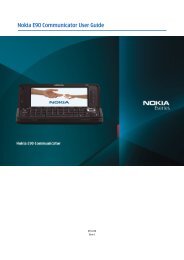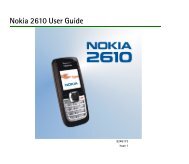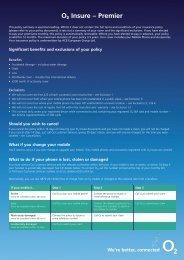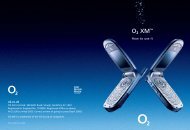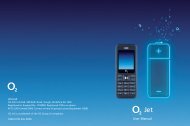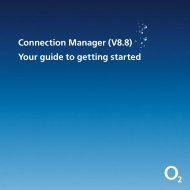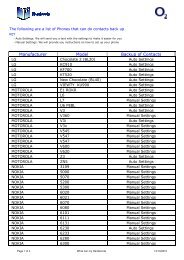GPRS and 3G Services: Connectivity Options - O2
GPRS and 3G Services: Connectivity Options - O2
GPRS and 3G Services: Connectivity Options - O2
You also want an ePaper? Increase the reach of your titles
YUMPU automatically turns print PDFs into web optimized ePapers that Google loves.
<strong>GPRS</strong> <strong>and</strong> <strong>3G</strong> <strong>Services</strong>:<br />
<strong>Connectivity</strong> <strong>Options</strong><br />
An <strong>O2</strong> White Paper
Contents<br />
Page No.<br />
3-4<br />
5-7<br />
5<br />
6<br />
7<br />
7<br />
8-10<br />
8<br />
10<br />
11-12<br />
11<br />
12<br />
13<br />
14<br />
15<br />
15<br />
15<br />
16<br />
17<br />
Chapter No.<br />
1. Executive Summary<br />
2. Bearer Service<br />
2.1. Overview<br />
2.2. DataLink<br />
2.3. Resilient DataLink<br />
2.4. Application Support<br />
3. Mobile Web<br />
3.1. Overview<br />
3.2. Application Support<br />
4. Mobile Web VPN<br />
4.1. Overview<br />
4.2. Application Support<br />
5. Service Comparison<br />
6. Appendix 1: IP Addresses used<br />
by the <strong>O2</strong> services<br />
7. Private IP Addresses used by <strong>O2</strong>’s<br />
Mobile Web Service<br />
7.1. No Optimisation<br />
7.2. Full Optimisation<br />
7.3. Web Optimisation<br />
8. Glossary of Terms
1. Executive Summary<br />
<strong>O2</strong>’s General Packet Radio Service (<strong>GPRS</strong>) <strong>and</strong> Third<br />
Generation (<strong>3G</strong>) services offer high speed wireless packet<br />
data capabilities to mobile devices connected to the<br />
network. These services enable devices to attach to the<br />
network <strong>and</strong> then establish data connections via both<br />
public <strong>and</strong> private domains. These domains are defined<br />
by use of an Access Point Name (APN), which is similar<br />
in structure <strong>and</strong> function to an Internet domain name.<br />
In the context of this paper <strong>O2</strong>’s <strong>GPRS</strong> <strong>and</strong> <strong>3G</strong><br />
connectivity portfolio consists of three service offerings:<br />
• <strong>O2</strong> Bearer Service: <strong>O2</strong> provides private circuit(s)<br />
to connect the customer network to <strong>O2</strong>’s network.<br />
The customer can select between 2 Bearer Service<br />
products:<br />
a. DataLink – consists of a single leased line <strong>and</strong> a<br />
router installed on the customer premises.<br />
b. Resilient DataLink – resilience is provided via the<br />
use of two leased lines <strong>and</strong> two routers.<br />
• <strong>O2</strong> Mobile Web service: full Internet access is provided.<br />
• <strong>O2</strong> Mobile Web Virtual Private Network (VPN)<br />
service: this service was specifically introduced to<br />
allow customers to access their Local Area Network<br />
(LAN) environment via VPN technology.<br />
When determining which service is most appropriate to<br />
a particular customers needs it is envisaged a number of<br />
factors will be considered including the following:<br />
• Cost of the service:<br />
- The Bearer Service options require that a leased<br />
line(s) <strong>and</strong> router(s) be provided by <strong>O2</strong> <strong>and</strong><br />
there is a yearly rental cost associated with the<br />
link(s) <strong>and</strong> router(s).<br />
- If a company does not already have a method<br />
for allowing people to access the corporate LAN<br />
via the Internet, via a VPN gateway for instance,<br />
they may find it preferable to use <strong>O2</strong>’s Bearer<br />
Service <strong>and</strong> choose an authentication approach<br />
which meets their requirements. This approach<br />
may prove a cheaper option than deploying<br />
new Internet facing gateways <strong>and</strong> using <strong>O2</strong>’s<br />
Mobile Web or Mobile Web VPN services.<br />
- End users are only charged for the data they send<br />
<strong>and</strong> receive <strong>and</strong> <strong>O2</strong>’s st<strong>and</strong>ard charges are the<br />
same regardless of which service is utilised (i.e.<br />
Bearer Service, Mobile Web or Mobile Web VPN).<br />
• What applications <strong>and</strong> services are going to be used?<br />
- Is there a requirement to limit what Internet<br />
resources people can access via <strong>GPRS</strong>/<strong>3G</strong>? Users<br />
can access any Internet server via <strong>O2</strong>’s Mobile<br />
Web service – although it is noted that personal<br />
firewalls can be used as a way of “policing”<br />
what Internet resources people can use.<br />
- Is there a requirement to interact with the<br />
mobile device from a server – perhaps to poll<br />
the remote client for instance? This may not be<br />
possible if <strong>O2</strong>’s Mobile Web <strong>and</strong> Mobile Web<br />
VPN services are used.<br />
- Do the applications work if Port Address<br />
Translation (PAT) is being used – <strong>O2</strong>’s Mobile<br />
Web service utilises PAT.<br />
3
- <strong>O2</strong>’s Mobile Web service includes optimisation<br />
which allows Web pages to be downloaded<br />
more quickly.<br />
- Are the mobile applications that are going to be<br />
deployed mission critical to an organisation? If<br />
they are, customers are recommended to use<br />
<strong>O2</strong>’s Bearer Service, preferably with a Resilient<br />
DataLink, as <strong>O2</strong> are responsible for all aspects<br />
of the Bearer Service.<br />
• What level of service <strong>and</strong> support is required?<br />
- Although <strong>O2</strong> endeavour to provide the<br />
highest level of service on all its <strong>GPRS</strong>/<strong>3G</strong><br />
services, if problems are experienced with the<br />
public services (i.e. Mobile Web or Mobile<br />
Web VPN services) it is far more difficult to<br />
ascertain what is happening <strong>and</strong> where the<br />
problem lies – for instance a number of ISPs<br />
may lie between <strong>O2</strong> <strong>and</strong> the customer.<br />
- <strong>O2</strong> pro-actively monitor the status of the<br />
Bearer Service <strong>and</strong> have established Service<br />
Level Agreements (SLAs) with the telecoms<br />
organisations that provide the leased line<br />
connections.<br />
- If customers procure the Bearer Service, <strong>O2</strong>’s<br />
technical consultancy teams will work with<br />
them to ensure they derive the required<br />
business benefit.<br />
Information on each of <strong>O2</strong>’s <strong>GPRS</strong>/<strong>3G</strong> services is provided<br />
in the following sections of this report.<br />
4
2. Bearer Service<br />
2.1. Overview<br />
<strong>O2</strong>’s Bearer Service offers business customers a high<br />
quality private mobile data connection to their own<br />
private domain.<br />
<strong>O2</strong>’s Bearer Service can be used to support both <strong>GPRS</strong><br />
<strong>and</strong> <strong>3G</strong> data traffic (e.g. the same infrastructure supports<br />
both <strong>3G</strong> <strong>and</strong> <strong>GPRS</strong> users).<br />
The key aspects of <strong>O2</strong>’s Bearer Service are as follows:<br />
• Each connection is defined by a unique, private<br />
Access Point Name (APN).<br />
• <strong>Connectivity</strong> is provided via a physical leased line that<br />
connects the <strong>O2</strong> network with the customer’s LAN.<br />
• Customers can define which Subscriber Identification<br />
Module (SIM) cards are able to access their APN.<br />
• The service does not provide any direct access<br />
to the Internet.<br />
• All private Bearer <strong>Services</strong> connect to resilient <strong>GPRS</strong><br />
Gateway Support Nodes (GGSN’s) in the <strong>O2</strong> network.<br />
The installation of this service offers customers the<br />
opportunity to design the mobile data connectivity<br />
service of their choice. Almost every aspect of the service<br />
can be configured to the customer’s requirements as<br />
this is a private service that connects customers to the<br />
<strong>O2</strong> <strong>GPRS</strong> <strong>and</strong> <strong>3G</strong> networks directly, using physical<br />
leased line infrastructure.<br />
This service is designed for customers that require a<br />
private connection to their company LAN, which will<br />
offer them the highest quality of service <strong>and</strong> most<br />
consistent data communications performance.<br />
<strong>O2</strong>’s Bearer Service is delivered <strong>and</strong> managed end-to-end<br />
by <strong>O2</strong> to ensure the smoothest service delivery <strong>and</strong><br />
shortest problem resolution timescales. <strong>O2</strong> proactively<br />
monitor the status of the service <strong>and</strong> produce detailed<br />
usage reports to ensure suitable service levels are<br />
maintained at all times.<br />
The leased line infrastructure offers the highest level of<br />
availability via two basic types of physical connection:<br />
DataLink (refer to section 2.2) <strong>and</strong> Resilient DataLink<br />
(refer to section 2.3).<br />
Customers wishing to order <strong>O2</strong> Bearer <strong>Services</strong> should<br />
discuss their options with their <strong>O2</strong> Account Manager in<br />
the first instance. A detailed, “Application For Service”,<br />
form is used to capture customer requirements <strong>and</strong><br />
service can be provided in 43 working days after this<br />
form has been processed.<br />
Customer configuration choices include:<br />
• APN name (normally the same as their Internet<br />
registered Domain Name).<br />
• Private (restricted) or Public (open) APN access.<br />
• <strong>O2</strong> or customer hosted RADIUS authentication.<br />
• Dynamic or static mobile device IP allocation.<br />
• Private or Public IP Addresses for the mobile devices.<br />
5
2.2. DataLink<br />
St<strong>and</strong>ard connectivity for Bearer Service customers is<br />
delivered via a single leased line (128 Kbit/s, 256 Kbit/s,<br />
512 Kbit/s <strong>and</strong> 2 Mbit/s b<strong>and</strong>widths are available),<br />
terminating on a single router that is installed, at the<br />
customer’s premises. Once installed, the router presents<br />
a single Ethernet or Token Ring connection to the<br />
customers LAN.<br />
Each DataLink can support multiple APNs, each with its<br />
own Bearer Service definition. This is useful where<br />
customers wish to provide separacy of service to<br />
different internal departments, external customers or<br />
application user bases.<br />
Radius<br />
Server<br />
DHCP<br />
Server<br />
GRE Tunnel<br />
<strong>O2</strong> Data Network<br />
Leased Line<br />
Firewall<br />
Corporate<br />
Network<br />
Remote User<br />
Figure 1:<br />
Typical <strong>GPRS</strong>/<strong>3G</strong> Bearer Service Connection.<br />
6
2.3. Resilient DataLink 2.4. Application Support<br />
For those customers requiring the very highest levels of<br />
availability, <strong>O2</strong> offers a Resilient DataLink leased line<br />
option to Bearer Service customers. Two links <strong>and</strong><br />
routers are provided as part of this solution.<br />
The two links <strong>and</strong> routers can be terminated at the same<br />
site. However, it is strongly recommended that they are<br />
deployed in different computer rooms which are served<br />
by different exchanges <strong>and</strong> duct routes.<br />
<strong>O2</strong> does not impose any restrictions on the type of data<br />
or ports that can be used for data transfer between the<br />
mobile devices <strong>and</strong> the corporate network. Consequently,<br />
all applications can be used in conjunction with <strong>O2</strong>’s<br />
Bearer Service.<br />
LAN connectivity is required between the two <strong>O2</strong> routers<br />
<strong>and</strong> Hot St<strong>and</strong>by Routing Protocol (HSRP) provides resilience<br />
against router failure by allowing two or more routers to<br />
share the same virtual IP address (<strong>and</strong> MAC address) on<br />
the same Ethernet LAN segment.<br />
7
3. Mobile Web<br />
3.1. Overview<br />
<strong>O2</strong>’s Mobile Web service is designed to enable <strong>O2</strong>’s<br />
customers to access Internet content via the <strong>GPRS</strong> <strong>and</strong><br />
<strong>3G</strong> bearers (refer to Figure 2).<br />
The key aspects of the service are as follows:<br />
• This is a public service <strong>and</strong> can be used by any <strong>O2</strong><br />
post-pay customer.<br />
• The APN associated with the service is<br />
“mobile.o2.co.uk”<br />
• Users are allocated a dynamic, private unregistered<br />
IP address. However, it should be noted that users<br />
of <strong>O2</strong>’s Mobile Web service will be allocated a public<br />
IP address, via an <strong>O2</strong> Internet facing firewall, when<br />
they access Internet resources. The public IP addresses<br />
will be allocated in the range 193.113.235.161 to<br />
193.113.235.190.<br />
• Users can surf the Internet, access FTP servers,<br />
access email <strong>and</strong> generally utilise Internet resources.<br />
• The service incorporates an optimisation capability<br />
which improves the performance of Internet<br />
applications.<br />
This service is similar to broadb<strong>and</strong> services offered by<br />
many Internet Service Providers to residential <strong>and</strong> business<br />
customers but does have some important differences:<br />
• The throughput performance available to users is<br />
not fixed <strong>and</strong> will depend on a number of factors<br />
including the <strong>GPRS</strong>/<strong>3G</strong> device being used, how<br />
many other people are using <strong>3G</strong>/<strong>GPRS</strong> in the same<br />
area <strong>and</strong> the capabilities of the <strong>O2</strong> network in a<br />
given geographic location. An <strong>O2</strong> White Paper,<br />
“<strong>GPRS</strong> – How It Works”, considers in detail what<br />
affects the throughput of the <strong>GPRS</strong> bearer.<br />
• The <strong>O2</strong> Mobile Web service uses private IP addressing<br />
<strong>and</strong> Port Address Translation (PAT) when users<br />
access Internet resources. PAT was defined by the<br />
Internet Engineering Task Force (IETF) as a way to<br />
convert private IP addresses to public routable<br />
Internet addresses <strong>and</strong> enables organisations to<br />
minimise the number of Internet IP addresses they<br />
require (e.g. by using PAT companies can connect<br />
thous<strong>and</strong>s of systems/users to the Internet via a few<br />
public IP addresses). The use of PAT has implications<br />
as although PAT provides many benefits, some<br />
applications, including IPSec VPNs, can experience<br />
issues when PAT is being used.<br />
• Devices are issued a dynamic, private unregistered IP<br />
address, which is not directly visible from the<br />
Internet. This means that user’s devices are hidden<br />
from hackers <strong>and</strong> other undesirables <strong>and</strong> affords<br />
users some protection when accessing the Internet.<br />
• By default Mobile Web users enjoy an optimised<br />
experience when accessing Internet content at no<br />
extra cost. This network hosted optimisation can<br />
speed up the delivery of Web pages by optimising<br />
graphic images <strong>and</strong> compressing text content. It can<br />
however degrade the image quality in Web pages<br />
<strong>and</strong> interfere with some other Internet applications.<br />
If this is experienced, the optimisation platform can<br />
be bypassed by changing the user name in the Mobile<br />
Web settings of the h<strong>and</strong>set/device, as follows:<br />
- Default settings – includes optimisation:<br />
• User name: faster<br />
• Password: password<br />
- No optimisation required:<br />
• User name: bypass<br />
• Password: password<br />
The Mobile Web APN is associated with all new <strong>O2</strong> post<br />
pay SIM cards. If customers do not wish this APN to be<br />
available to users they should specify this requirement<br />
prior to SIMs being provisioned.<br />
<strong>O2</strong> plan to introduce an anti-spam filtering capability in<br />
the near future.<br />
8
<strong>O2</strong> Data Network<br />
GRE Tunnel<br />
Leased Line<br />
<strong>O2</strong> Mobile Web Service<br />
Firewall<br />
Remote User<br />
Radius Server<br />
(allocates Private IP Addresses)<br />
Internet<br />
Figure 2:<br />
Top Level Overview of <strong>O2</strong>’s Mobile Web Service.<br />
9
3.2. Application Support<br />
Most applications will work in conjunction with <strong>O2</strong>’s Mobile<br />
Web service without any problems being experienced.<br />
However, as detailed in section 3.1 <strong>O2</strong>’s Mobile Web<br />
service does incorporate an optimisation cluster <strong>and</strong> this can<br />
have an undesirable impact on some applications. If<br />
problems are experienced the user name bypass should<br />
be used to remove the optimisation functionality.<br />
If there is a requirement to interact with the mobile device<br />
from a server (i.e. perhaps to poll the remote client for<br />
instance) then the following must be taken into account:<br />
• If a Transmission Control Protocol (TCP) based<br />
application is being used it will not be possible to<br />
poll the mobile device from the server. The firewall<br />
that underpins the <strong>O2</strong> Mobile Web service will only<br />
allow TCP sessions to the mobile device if it is a<br />
continuation of an existing TCP session that was<br />
started by the mobile device.<br />
• If a User Datagram Protocol (UDP) based application<br />
is being used it is possible to poll the mobile device<br />
from the server. However, as <strong>O2</strong>’s Mobile Web<br />
service uses Port Address Translation (PAT) to<br />
conserve IP addresses the IP address, source port<br />
<strong>and</strong> destination port being used by the mobile<br />
device application must be captured at the server. In<br />
order to send UDP data back to the mobile device<br />
the source port of the server sent data must be the<br />
same as the destination port of the received data<br />
from the mobile – similarly the destination port of<br />
the server sent data needs to be the same as the<br />
source port of the received data from the mobile.<br />
The following example illustrates what must be<br />
done at the server:<br />
The UDP packets received at a server from a mobile<br />
device have the following parameters – ports chosen<br />
at r<strong>and</strong>om:<br />
- IP address: 193.113.235.167.<br />
- Source port: 8000.<br />
- Destination port: 3000.<br />
In order to send UDP packets back from the server<br />
to the mobile device the following parameters<br />
would need to be used:<br />
- IP address: 193.113.235.167.<br />
- Source port: 3000<br />
- Destination port: 8000<br />
It should also be noted that the UDP session will be<br />
terminated if there is inactivity for 15 minutes or more<br />
i.e. if no data has been sent from the mobile for 15<br />
minutes or longer the UDP session will be “torn down”<br />
by the firewall.<br />
Unless customers wish to support split tunnelling they<br />
are recommended to use <strong>O2</strong>’s Mobile Web VPN service<br />
in conjunction with their IPSec based VPN solution (refer<br />
to section 4 for more information on <strong>O2</strong>’s Mobile Web<br />
VPN Service).<br />
Split tunnelling is the process of allowing a remote VPN<br />
user to access the Internet at the same time that the user<br />
is allowed to access resources on the corporate LAN via<br />
the VPN Service. This method of network access enables<br />
the user to access remote resources, such as corporate<br />
email, at the same time as accessing the public network.<br />
An advantage of using split tunnelling is that it alleviates<br />
bottlenecks <strong>and</strong> conserves b<strong>and</strong>width as Internet traffic<br />
does not have to pass through the VPN server. A<br />
disadvantage of this method is that the corporate LAN IP<br />
policy is not imposed on the user as they access the<br />
Internet directly.<br />
Point-to-Point Tunnelling Protocol (PPTP) <strong>and</strong> Secure<br />
Sockets Layer (SSL) based VPN solutions can be used in<br />
conjunction with <strong>O2</strong>’s Mobile Web service.<br />
10
4. Mobile Web VPN<br />
4.1. Overview<br />
<strong>O2</strong>’s Mobile Web VPN service was specifically developed<br />
to allow customers to use their VPN solutions with <strong>GPRS</strong><br />
<strong>and</strong> <strong>3G</strong> – assuming the customers VPN solution can be<br />
utilised via people connected to the Internet (refer to<br />
Figure 3).<br />
The key aspects of the service are as follows:<br />
• This is a public service <strong>and</strong> can be used by any <strong>O2</strong><br />
post-pay customer.<br />
• The APN associated with the service is “vpn.o2.co.uk”<br />
• Users are allocated a dynamic, public registered IP<br />
address that is drawn from the following ranges:<br />
- 82.132.160.1 to 82.132.163.254.<br />
- 82.132.168.1 to 82.132.171.254.<br />
• Users cannot directly “surf” the Internet, access FTP<br />
servers, access email or utilise Internet resources:<br />
- At the request of customers the service was<br />
set-up so only VPN protocols can be used when<br />
users first establish their <strong>GPRS</strong> or <strong>3G</strong> connection<br />
e.g. the firewall associated with the service will<br />
block all other traffic.<br />
- Once the VPN session is in place users will be<br />
able to browse the Intranet/Internet <strong>and</strong><br />
access other corporate resources – assuming<br />
the corporate security policy allows such<br />
transactions to take place.<br />
- Split tunnelling will not work as users are not<br />
able to access Internet resources directly.<br />
The <strong>O2</strong> Mobile Web VPN service does not include any<br />
optimisation capability, <strong>and</strong> end user devices are<br />
allocated publicly registered IP addresses. The service<br />
offers businesses the ability to provide secure LAN<br />
access to their users via the Internet <strong>and</strong> control their<br />
usage through the application of their internal IT policy.<br />
Access to Mobile Web VPN can be requested via <strong>O2</strong><br />
Customer <strong>Services</strong> <strong>and</strong> is usually provisioned within<br />
24 hours.<br />
<strong>O2</strong> Data<br />
Network<br />
Leased Line<br />
GRE Tunnel<br />
<strong>O2</strong> Mobile Web VPN Service<br />
Firewall<br />
Remote User<br />
Radius Server<br />
(allocates Public<br />
IP Addresses)<br />
VPN Server<br />
Internet<br />
VPN Tunnel<br />
Corporate Network<br />
Figure 3:<br />
A VPN Tunnel Established between a Remote User<br />
<strong>and</strong> the Corporate LAN.<br />
11
4.2. Application Support<br />
The VPN solutions supported can be summarised as<br />
follows:<br />
• Only IP ports associated with VPN protocols can<br />
be used when users first establish their <strong>GPRS</strong> or <strong>3G</strong><br />
connection.<br />
• The supported VPN protocols are IPSEC, L2TP, PPTP<br />
<strong>and</strong> SSL. <strong>O2</strong>’s White Paper titled, “<strong>O2</strong>’s <strong>GPRS</strong>/<strong>3G</strong><br />
<strong>Services</strong>: VPN Solutions Supported”, provides<br />
detailed information on the protocols <strong>and</strong> ports that<br />
are supported by the service.<br />
• Tracert <strong>and</strong> ping are supported for connectivity testing.<br />
12
5. Service Comparison<br />
5. Service Comparison<br />
Table 1 summarises the differences between the <strong>O2</strong><br />
<strong>GPRS</strong>/<strong>3G</strong> services.<br />
Service Comparison Matrix<br />
Metric<br />
Bearer Service<br />
Mobile Web<br />
Mobile Web VPN<br />
APN<br />
Customers Choice<br />
mobile.o2.co.uk<br />
vpn.o2.co.uk<br />
Access Type<br />
Public or Private<br />
Public<br />
Public<br />
Number of devices<br />
supported<br />
Unlimited<br />
Unlimited<br />
Unlimited<br />
Direct Internet<br />
<strong>Connectivity</strong><br />
Internet <strong>Connectivity</strong> via<br />
corporate LAN – subject<br />
to IT policy<br />
Yes<br />
Internet <strong>Connectivity</strong> via<br />
corporate LAN – subject<br />
to IT policy<br />
Mobile IP Addresses<br />
Customers Choice<br />
Private (PAT) 1<br />
Public<br />
IP Address Allocation<br />
Customers Choice<br />
Dynamic<br />
Dynamic<br />
Supported Protocols<br />
All<br />
Most Internet<br />
VPN Only<br />
Bearer Optimisation<br />
Customers Choice<br />
Optional<br />
No<br />
Content Optimisation<br />
Customers Choice<br />
Optional<br />
No<br />
TCP Inactivity Timeout<br />
Customer Choice<br />
30 minute<br />
30 minute<br />
UDP Inactivity Timeout<br />
Customer Choice<br />
15 minute<br />
15 minute<br />
Access Lead Time<br />
43 working days<br />
Immediate<br />
6. Appendix 1<br />
6. IP Addresses used by the <strong>O2</strong> services<br />
Service<br />
Public IP Address Range<br />
Availability<br />
Start<br />
End<br />
Start<br />
End<br />
Mobile Web<br />
193.113.235.161<br />
193.113.235.190<br />
Current<br />
N/A<br />
Mobile Web VPN<br />
82.132.160.1<br />
82.132.163.254<br />
Current<br />
N/A<br />
82.132.168.1<br />
82.132.171.254<br />
Current<br />
N/A<br />
14
7. Private IP Addresses used by <strong>O2</strong>’s Mobile<br />
Web Service<br />
7.1. No Optimisation 7.2. Full Optimisation<br />
If a user name of bypass is used (no optimisation) a private<br />
IP address from the following ranges will be allocated to<br />
the end device:<br />
If a user name of faster is used (full optimisation) a<br />
private IP address from the following ranges will be<br />
allocated to the end device:<br />
• 10.228.160.1-10.228.167.254<br />
• 10.228.168.1-10.228.175.254<br />
• 10.228.176.1-10.228.191.254<br />
• 10.233.168.1-10.233.175.254<br />
• 10.233.176.1-10.233.183.251<br />
• 10.233.184.1-10.233.191.251<br />
• 10.228.192.1-10.228.207.254<br />
• 10.228.208.1-10.228.223.254<br />
• 10.228.224.1-10.228.255.254<br />
• 10.233.192.1-10.233.223.254<br />
• 10.233.224.1-10.233.239.251<br />
• 10.233.240.1-10.233.255.251<br />
15
7.3. Web Optimisation<br />
If a user name other than faster or bypass is used (Web<br />
optimisation) a private IP address from the following<br />
ranges will be allocated to the end device:<br />
• 10.225.1.1-10.225.255.254<br />
• 10.226.1.1-10.226.255.254<br />
• 10.234.1.1-10.234.255.254<br />
• 10.235.1.1-10.235.255.254<br />
• 10.247.1.1-10.247.255.251<br />
• 10.249.1.1-10.249.255.251<br />
16
Glossary of Terms<br />
8. Glossary of Terms<br />
<strong>3G</strong><br />
APN<br />
DHCP<br />
FTP<br />
GGSN<br />
<strong>GPRS</strong><br />
GSM<br />
HSRP<br />
IP<br />
IPSec<br />
LAN<br />
L2TP<br />
MMS<br />
PAT<br />
PPTP<br />
Third Generation mobile phone service<br />
(AKA: UMTS)<br />
Access Point Name<br />
Dynamic Host Configuration Protocol<br />
File Transfer Protocol<br />
<strong>GPRS</strong> Gateway Support Nodes<br />
General Packet Radio Service<br />
Global System for Mobile Communications<br />
Hot St<strong>and</strong>by Routing Protocol<br />
Internet Protocol<br />
IP Security<br />
Local Area Network<br />
Layer 2 Tunnelling Protocol<br />
Multimedia Messaging Service<br />
Port Address Translation<br />
Point-to-Point Tunnelling Protocol<br />
RADIUS Remote Access Dial In User Service<br />
SIM<br />
SMS<br />
SSL<br />
TCP<br />
UDP<br />
UMTS<br />
VPN<br />
WAP<br />
Subscriber Identification Module<br />
Short Message Service<br />
Secure Sockets Layer<br />
Transmission Control Protocol<br />
User Datagram Protocol<br />
Universal Mobile Telephone Service<br />
Virtual Private Network<br />
Wireless Application Protocol<br />
All Rights Reserved. No part of his document may be copied, photocopied, reproduced, translated or reduced to any electronic or machine readable form without the prior permission of <strong>O2</strong> Limited.<br />
17


